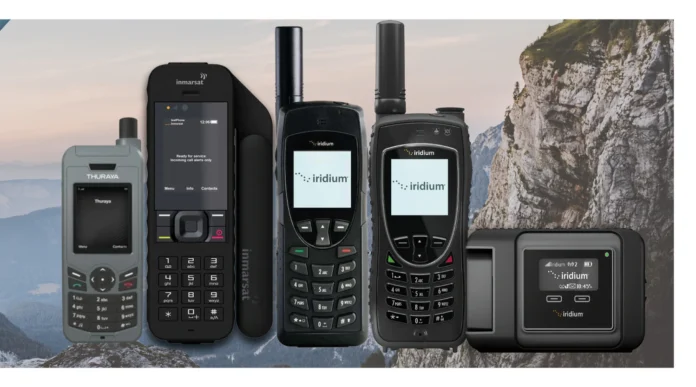In an age of instant messaging and 5G, it’s hard to imagine places where your mobile phone just won’t work. But if you’ve ever ventured deep into the Himalayas, remote oceans, deserts, or disaster-stricken zones, you’ll know that cellular networks have limits. That’s where satellite phones (also known as satphones) come in.
But how do satellite phones work? Why can they connect in the middle of nowhere while regular phones can’t? This blog breaks it down — clearly, simply, and with all the tech insights you need.
🌐 What Is a Satellite Phone?
A satellite phone is a mobile communication device that connects directly to satellites orbiting the Earth, rather than relying on terrestrial cell towers. This allows users to make voice calls, send texts, and access limited data services anywhere on Earth, including remote areas, oceans, or polar regions.
🛰️ How Satellite Phones Work – Step-by-Step Explanation
Here’s a simplified flow of how a satellite phone works:
1. Signal Transmission from Phone
When you make a call or send a message using a satellite phone, the signal is transmitted upward to a communication satellite instead of to a nearby cell tower.
2. Satellite Relays the Signal
The satellite receives the signal and either:
- Transmits it directly to another satellite phone, or
- Relays it to a ground station (gateway) connected to the public telephone network.
3. Connection Established
If going through a gateway, the call is routed via PSTN (Public Switched Telephone Network) to reach a landline or mobile network.
4. Signal Travels Back
When someone calls your satellite phone, the process reverses — starting at a landline/cell network, moving through the satellite network, and finally reaching your satphone.
🧭 Types of Satellite Networks
Satellite phones operate over two main types of satellite constellations:
| Type | Description | Example Providers |
|---|---|---|
| LEO (Low Earth Orbit) | 500–2,000 km above Earth; low latency | Iridium, Globalstar |
| GEO (Geostationary) | 35,786 km; remains over one location | Inmarsat, Thuraya |
Key Differences:
- LEO Satellites offer better coverage and faster connection, but require a network of satellites due to constant motion.
- GEO Satellites are stationary but need a clear line of sight to the southern sky (in Northern Hemisphere) for best performance.
🔋 Features of Modern Satellite Phones
| Feature | Available In |
|---|---|
| Voice Calls | All satellite phones |
| SMS Messaging | Most models |
| GPS Tracking | Iridium, Garmin inReach, Thuraya |
| Email & Data | Limited to 2.4–64 kbps speeds |
| SOS & Emergency Alerts | Specialized models like inReach |
| Rugged Build | Weatherproof, dustproof, shockproof |
| Long Battery Life | 8–24 hours talk time, days on standby |
📡 Satellite Phones vs Mobile Phones
| Feature | Satellite Phone | Mobile Phone |
|---|---|---|
| Coverage | Global (with open sky) | Limited to cellular zones |
| Network Dependency | Satellite orbit | Cellular towers |
| Internet Speed | Very slow (max 64 kbps) | 4G/5G high speed |
| Call Reliability | Affected by obstructions | Better in cities |
| Cost (Call/Data) | High (₹30–₹200/min) | Low |
| Usability Indoors | Poor (needs clear sky) | Great |
📦 Popular Satellite Phones in 2025
| Model Name | Network | Key Features | Price (₹) |
|---|---|---|---|
| Iridium 9575 Extreme | Iridium | Global coverage, SOS, rugged build | ₹95,000+ |
| Thuraya XT-LITE | Thuraya | Affordable, compact, basic features | ₹65,000+ |
| Inmarsat IsatPhone 2 | Inmarsat | Long battery, GPS, global roaming | ₹85,000+ |
| Garmin inReach Mini 2 | Iridium | 2-way text, SOS, GPS, small & light | ₹40,000+ |
Note: Satellite phones require a service subscription to work, often with prepaid or postpaid plans.
🇮🇳 Can You Use Satellite Phones in India?
Yes, but with strict regulations.
In India, using a satellite phone without permission is illegal. Only models using Inmarsat networks with DoT clearance are allowed, and primarily for:
- Government use (defense, disaster management)
- Foreign tourists with temporary permits
- Mountaineers with special authorization
Important: Unauthorized use of satphones in India can lead to confiscation, fines, or even jail time under the Indian Telegraph Act.
🎯 Use Cases of Satellite Phones
- 🏕️ Expeditions & Hiking in remote mountains or jungles
- 🌊 Marine navigation & shipping vessels
- 🌪️ Disaster zones where telecom towers are destroyed
- 📡 Oil rigs, mines, remote field work
- 🧳 International travel to remote regions
🙋 Frequently Asked Questions (FAQs)
1. Do satellite phones work indoors?
Not effectively. Satellite phones need a clear line of sight to the sky for signal.
2. Can you use WhatsApp or internet?
No. Most satellite phones support only very slow data (text-based emails). No video calls, WhatsApp, or browsing.
3. How much does it cost to use a satphone?
Calling rates range from ₹30 to ₹200 per minute, and SMS costs vary. Subscription plans may start around ₹1,000/month.
4. Are satellite phones traceable?
Yes. Most satellite networks use GPS or GLONASS, and calls can be logged or monitored based on regulations.
📝 Final Thoughts
Satellite phones are lifelines for remote communication, offering unmatched reliability in places where nothing else works. From saving lives during disasters to enabling explorers to stay in touch, satphones are essential tools for the edge of the world.
While expensive and regulated, especially in countries like India, they represent the pinnacle of mobile connectivity when all else fails.
📡 Whether you’re a mountaineer, mariner, or part of a disaster response team — a satellite phone could be your ultimate backup.

